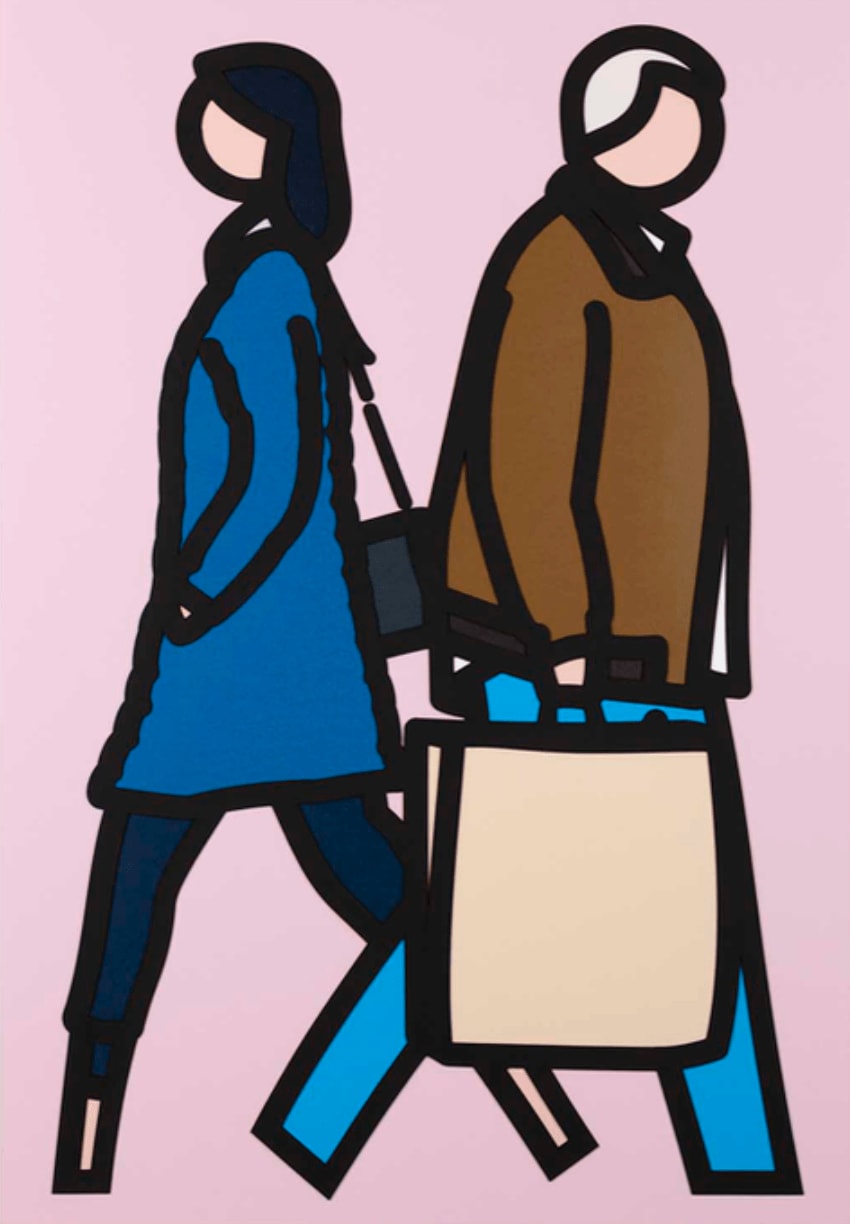
Julian Opie
New York Couple 3, 2019
Screen print with inkjet and collage on conservation board with frame
44 1/8 x 30 3/4 in
112 x 78 cm
112 x 78 cm
Edition of 55 plus 5 AP
Series: New York Couples
Copyright The Artist
Julian Opie's work 'New York Couple' is a striking example of the British artist's distinctive style, which merges the visual language of contemporary graphic design with themes from classical portraiture...
Julian Opie's work "New York Couple" is a striking example of the British artist's distinctive style, which merges the visual language of contemporary graphic design with themes from classical portraiture and sculpture. Known for his simplified depictions of human figures, landscapes, and urban scenes, Opie distills complex forms into minimalistic representations, using flat areas of color and black outlines to create highly stylized images that are instantly recognizable.
"New York Couple" encapsulates Opie's exploration of urban life and the individual within the public space. This work is part of a broader series of portraits and figures that Opie has developed over the years, where he focuses on capturing the essence of his subjects through reduced forms and details. The piece typically features one or two figures, portrayed in Opie's signature reductionist approach, emphasizing the flow and movement of city life while also offering a snapshot of contemporary society.
Opie's technique involves the use of computer software to refine photographs into the basic elements of line and color, stripping away extraneous detail to focus on the universal qualities of form and posture. This process results in figures that are both specific and anonymous, offering a generic template of urban dwellers that viewers can easily relate to or even project themselves onto. "New York Couple" showcases this technique beautifully, presenting the subjects in a manner that is both intimate and impersonal, capturing the paradoxical nature of city living.
The artwork's aesthetic is reminiscent of modern signage and iconography, blurring the boundaries between fine art and commercial design. This blurring is intentional, as Opie seeks to engage with the visual culture of the 21st century, where the lines between art, advertising, and everyday life are increasingly intertwined. His work invites viewers to consider the ways in which art can reflect and shape our understanding of the world, using the language of contemporary graphic design to comment on the human condition.
"New York Couple" is not just a representation of two individuals but a commentary on the nature of visibility, anonymity, and the role of art in an urban context. Through this work, Opie asks us to consider how we see and are seen in the bustling environment of the city, where personal identities are both displayed and dissolved in the public sphere. The piece is a reflection on modern life, offering a lens through which to view the complexities of social interaction and urban dynamics in the digital age.
Julian Opie's "New York Couple" exemplifies the artist's ongoing fascination with the rhythms and patterns of urban existence, as well as his mastery of a visual style that is both reductionist and profoundly expressive. Through his innovative use of technology and his engagement with the themes of visibility and identity, Opie continues to contribute to the dialogue between traditional portraiture and contemporary digital culture, making his work relevant and resonant in today's art world.
"New York Couple" encapsulates Opie's exploration of urban life and the individual within the public space. This work is part of a broader series of portraits and figures that Opie has developed over the years, where he focuses on capturing the essence of his subjects through reduced forms and details. The piece typically features one or two figures, portrayed in Opie's signature reductionist approach, emphasizing the flow and movement of city life while also offering a snapshot of contemporary society.
Opie's technique involves the use of computer software to refine photographs into the basic elements of line and color, stripping away extraneous detail to focus on the universal qualities of form and posture. This process results in figures that are both specific and anonymous, offering a generic template of urban dwellers that viewers can easily relate to or even project themselves onto. "New York Couple" showcases this technique beautifully, presenting the subjects in a manner that is both intimate and impersonal, capturing the paradoxical nature of city living.
The artwork's aesthetic is reminiscent of modern signage and iconography, blurring the boundaries between fine art and commercial design. This blurring is intentional, as Opie seeks to engage with the visual culture of the 21st century, where the lines between art, advertising, and everyday life are increasingly intertwined. His work invites viewers to consider the ways in which art can reflect and shape our understanding of the world, using the language of contemporary graphic design to comment on the human condition.
"New York Couple" is not just a representation of two individuals but a commentary on the nature of visibility, anonymity, and the role of art in an urban context. Through this work, Opie asks us to consider how we see and are seen in the bustling environment of the city, where personal identities are both displayed and dissolved in the public sphere. The piece is a reflection on modern life, offering a lens through which to view the complexities of social interaction and urban dynamics in the digital age.
Julian Opie's "New York Couple" exemplifies the artist's ongoing fascination with the rhythms and patterns of urban existence, as well as his mastery of a visual style that is both reductionist and profoundly expressive. Through his innovative use of technology and his engagement with the themes of visibility and identity, Opie continues to contribute to the dialogue between traditional portraiture and contemporary digital culture, making his work relevant and resonant in today's art world.